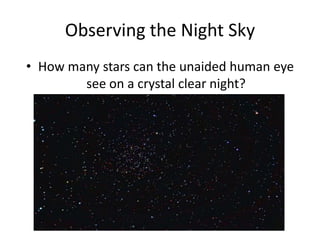
Constellations
- 1. Observing the Night Sky • How many stars can the unaided human eye see on a crystal clear night?
- 2. Visible stars on a clear night • Unaided human eye – 6,000 stars • At any one time – 3,000 stars – ½ above horizon, ½ below horizon • Reality – light pollution and other factors limit visible stars to a few hundred – Suburban: 500+ – Inner-city: 300+
- 3. The Magnitude Scale • The apparent brightness of celestial objects is measured on a scale of apparent magnitude (mv). • The brightest stars are ~ 1st magnitude or less • Faintest stars (unaided eye) are ~ 6th magnitude. • This is a logarithmic scale with a base of 2.512 – A 1st magnitude star is 2.512 times brighter than a 2nd magnitude star – How many times brighter is a 1st magnitude star compared to a 6th magnitude star?
- 4. Intensity Ratio (how many times brighter) • 2.512 ^ (mv1 – mv2) • 2.512 ^ (6-1) = 100 • How many times brighter is Sirius (mv = -1.42) than Polaris (mv = 1.97)
- 5. Constellations In ancient times, constellations only referred to the brightest stars that appeared to form groups, representing mythological figures.
- 6. Today, constellations are well-defined regions on the sky, irrespective of the presence or absence of bright stars in those regions. They serve as a way to break up and organize the sky (celestial sphere).
- 7. Constellations Stars are named by a Greek letter ( ) according to their relative brightness within a given constellation + the possessive form of the name of the constellation: Orion Betelgeuse = Orionis Betelgeuze Rigel = Orionis Rigel
- 8. How can we use the Constellations? • Think of the constellations as a map of the sky. The more constellations you can recognize the better your ability to navigate the night sky will be. • Every celestial object can be found within a constellation. Knowing the constellations tells you where to look for objects and phenomena like planets, galaxies, comets, and meteor showers.
- 9. Looking at the Sky • Constellations – 88 official constellations according to the IAU (International Astronomical Union) • Many origins – Greeks, Southern European cultures, Middle East, Asia, etc. • Stars define the celestial sphere • Question: Are the stars of a Constellation close to each other?
- 10. Projection Effect: The stars of a constellation only appear to be close to one another. The stars of a constellation may be located at very different distances from us.
- 11. Asterism vs. Constellation • An asterism is a star pattern that is not a Constellation – Examples: The Big and Little Dipper, the Summer Triangle, and the Winter Hexagon
- 12. Our View of the Sky • Our view changes because of the motions that occur in the solar system. – Earth is spinning (rotating) – Earth is orbiting (revolving) the Sun – The Moon is orbiting Earth – The other planets are also orbiting the Sun
- 13. Paths of Stars • Earth’s counter-clockwise rotation – Stars rise in the East, set in the West • But some stars never set! – Polaris stays nearly stationary in the sky – Stars near Polaris move slightly, in circular, counter- clockwise paths – Some objects are never visible from the north • The Southern Cross (SH) • Star positions change from night to night as the Earth revolves about the Sun – rise and set 4 minutes earlier each day.
- 14. Risings and Settings (apparent motion) The spin of the earth causes the stars to appear to rotate about the celestial pole. Some stars are therefore circumpolar and never set, while others dip below the horizon. Which stars are which depend on where you are on earth.
- 16. The Yearly Motion In addition to rotating, the Earth alsorevolvesabout the Sun. One revolution = 365.242 days. As the earth revolves the Sun is projected in front of different constellations at different times of year. The path the Sun takes across heavens is called the ecliptic.The constellations which the Sun passes through arezodiac constellations. Because the Sun is bright, we can only see some constellations at certain times of year.
- 18. Misconceptions about yearly motion: The cause of the seasons… Misconception #1: Misconception #2: • The distance between Earth • Because we are tilted and the Sun create seasons. towards the Sun in the Month Earth-Sun Summer we are closer to it Distance and therefore it is warmer. December 147.2 million km • If 4.8 million km doesn’t March 149.0 million drastically affect the km seasons, then the fact that June 152.0 million we are slightly closer to the km Sun when tilted towards it September 150.2 million has no effect at all… km
- 19. Seasons • Seasonal change is the result of the Angle of Incidenceof the Sun’s rays and the length of day (seasons animation).